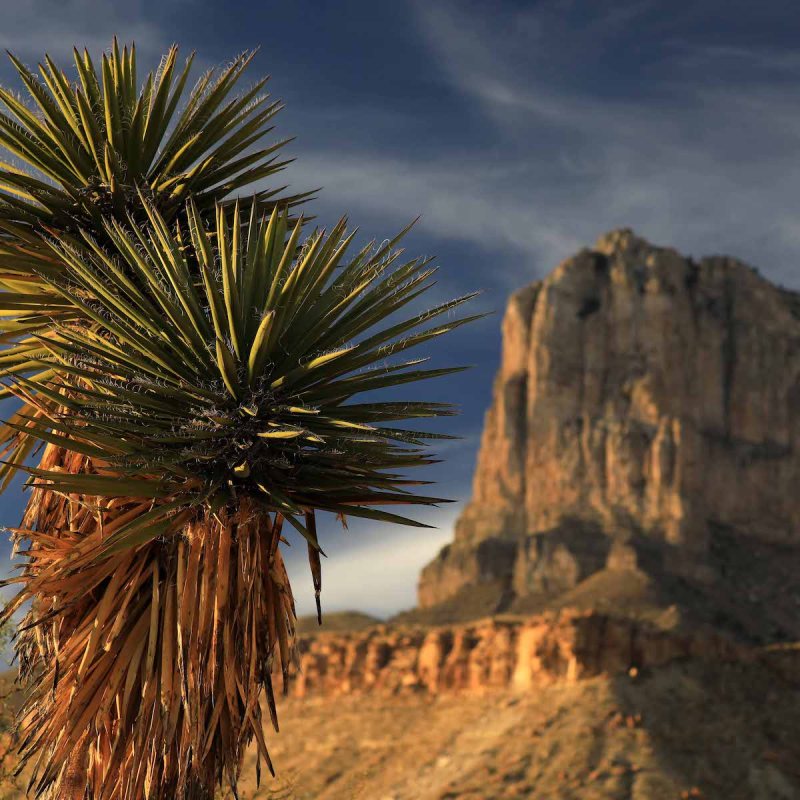
Expanding the Chihuahuan Desert of southwestern Texas to the majestic Piney Woods trees in eastern Texas, you’ll find 16 of Texas’s most incredible national parks. Technically, you’ll find two national parks, national monuments, national recreational areas, national historic sites, national trails, and a seashore. Whether looking for an affordable or diverse Texas vacation, you’ll find a park within a few hours’ drive.
Videos by TravelAwaits

1. Big Bend National Park
In the vast Chihuahuan Desert of southwestern Texas, Big Bend National Park was once ancient dinosaur fossil-filled lake beds where the Rio Grande carved narrow, deep limestone canyons that made the elbow curve marking the state border from Mexico. The park encompasses more than 801,160 acres of dark skies and rugged landscape.
The remote park protects 75 species of mammals, over 450 bird species, 56 different reptiles, and 1,200 individual plants, providing many park ranger programs, 150 miles of hiking trails, scenic drives, and stargazing.
We stayed at the luxurious 27,000-acre Lajitas Golf Resort on the park’s west side.
Pro Tips: Or stay at Chisos Mountain Lodge in the Chisos Basin, but make your reservations 6 months or more ahead. The lodge restaurant offers continental breakfast, lunch, and dinner. Camping with reservations is available at Rio Grande Village RV Park and three other developed campgrounds.
2. Guadalupe Mountains National Park
El Capitan — one of the tallest of the Guadalupe Mountains towering 8,085 feet above the West Texas desert floor along Highway 62/180 — beckons hikers, campers, and backpackers to the remote wilderness and solitude of this rugged national park.
Start at Pine Springs Headquarters and Visitor Center, tour the park museum, and stock up on brochures, maps, and camping items at the park store. Talk to the park rangers regarding trail recommendations and backcountry conditions.
Hike Guadalupe Peak from Pine Springs Trailhead, 8.5 miles to the summit and back with a 3,000-foot elevation gain, averaging 6–8 hours round trip.
Camp at Pine Springs Campground with 19 RV sites marked off in the parking lot, all first come, first served. When visiting the national park, come with a full tank of gas, food, and water, as there are no restaurants, lodging, or gas stations in or near the park. Cell phone service is spotty, so bring paper maps of the state and the park.
Pro Tip: The closest towns are Dell City to the west and Whites City 35 miles east in New Mexico. Add Salt Flat, Texas, and Carlsbad, New Mexico, to your weather app and be cautious about hazardous weather and flash flooding.

3. Lyndon B. Johnson National Historical Park
Learn about the life of our 36th President, Lyndon B Johnson, and his birth, early family life, political career, presidency, and family burial site at LBJ National Historical Park.
Take a driving tour through the park and see LBJ’s first school, where he signed the landmark Elementary and Secondary Education Act of 1965. Having been a teacher in his early career, LBJ signed more educational bills into law than any other president.
Other stops include the family cemetery with the LBJ, Ladybird, and family graves; the LBJ Ranch Show Barn; and the airplane hangar, housing a replica of the plane that flew the president and his family from Washington, D.C. to the Texas Whitehouse.
4. Padre Island National Seashore
The longest undeveloped barrier island in the world, Padre Island National Seashore encompasses a 70-mile protected coastline, the rare hypersaline Laguna Madre, a complex dune system, tidal flats, and a rare coastal prairie.
Nearly half of all bird species documented in North America migrate over winter and reside along this central flyway of Padre Island. Thirteen of the more than 380 bird species are threatened or endangered.
Padre Island hosts the Kemp’s ridley sea turtle nesting and hatchling releases into the wild from April to mid-July.
The Malaquite Visitor Center is the headquarters for information, ranger-led programs, restrooms, park store, exhibit, and picnic area.

5. San Antonio Missions National Historical Park
The only UNESCO World Heritage Site in Texas, the San Antonio Missions National Historical Park features five San Antonio Missions and four active parishes that conduct mass every Sunday. Start 3 miles south of downtown at Mission Concepción. Next is Mission San Jose and the park’s visitor center, 2.5 miles south. Find Mission San Juan and a Spanish Colonial demonstration farm 3 miles farther. The farthest south is Mission Espada.
What is the fifth mission? The fifth mission is the Alamo, or Mission San Antonio de Valero, founded in 1718.
6. Amistad National Recreational Area
The Pecos River, Devils River, and Rio Grande unite to form the Amistad National Recreational Area — a long, curving Amistad Reservoir about 10 miles north of Del Rio, Texas. In Spanish, Amistad means “friendship.” The United States and Mexico share and manage the reservoir, an oasis in the desert. Americans and Mexicans celebrate the Friendship Festival annually, Fiesta de La Amistad.
Camp at one of five designated campgrounds in the park: Governors Landing, Rough Canyon, San Pedro, Spur 406, and 277 North. Sites are available on a first come, first served basis, payable at the campground’s self-pay fee station.

7. Fort Davis National Historic Site
One of the best examples of a frontier military post in the Southwest, Fort Davis was built to protect settlers, mail coaches, and shipments along the Trans-Pecos and San Antonio-El Paso Road from 1854–1891. After the Act of 1866, which allowed African Americans to join the service, buffalo soldiers served the military in West Texas from 1867–1885.
Plan an afternoon to see the 15-minute video about the fort’s history and explore its five restored and refurnished buildings and other ruins. Hike the trails surrounding the fort and complete the Junior Ranger program.
8. Big Thicket National Preserve
Have you seen a carnivorous plant like a sundew, pitcher plant, bladderwort, or butterwort that gets most of its nutritional needs from the insects they consume? These four plants live in the Big Thicket, the national preserve protecting nine ecosystems in East Texas, established in 1974.
Start your trip at the Big Thicket Visitor Center, about 7 miles north of Kountze at the intersection of U.S. 69/287 and FM 420. Get free trail maps and information, explore exhibits, watch a 16-minute film about the Big Thicket, and shop the park store for souvenirs. Pick up a free backcountry camping permit or picnic at a shelter.
Nearly 300 species of birds migrate along the flyway through the Big Thicket, of which 74 species nest within the preserve. See several types of woodpeckers along the Sundew Trail or Swainson’s warblers on the Kirby Nature Trail.

9. Rio Grande Wild & Scenic River
The Rio Grande Wild & Scenic River is a U.S. National Wild and Scenic River that protects 196 miles of the Rio Grande from the Chihuahua/Coahuila state line in Mexico to the Terrell/Val Verde County line in Texas. Big Bend National Park oversees this portion as the Wild & Scenic River.
Enjoy a float trip along the 33-mile Boquillas Canyon, which is excellent for visitors with less experience. The 10-mile Mariscal Canyon float provides fantastic scenery and a little bit of rapid excitement. Take a relaxing half-day float through Hot Springs Canyon for all skill levels. For those with more experience, the Lower Canyons’ 5- to 10-day float trip offers deep canyons and an open-desert landscape. Please be sure to follow safety regulations.
10. Waco Mammoth National Monument
Can you imagine discovering a huge bone eroding from a ravine when you went searching for arrowheads along the Bosque River? The Strecker Museum at Baylor University identified the find as a femur bone from a Columbian mammoth — standing as tall as 14 feet and weighing 20,000 pounds — that lived during the Ice Age.
The museum staff and volunteers at the Waco Mammoth National Monument excavated the site between 1978 and 1990, uncovering the fossil remains of 16 Columbian mammoths, plus six additional mammoths, including a male bull. Today, the monument sits on 100 wooded acres along the Bosque River.
11. Alibates Flint Quarries National Monument
Start at the Alibates Visitor Center to see museum exhibits and an award-winning film about Alibates Flint Quarries National Monument in the Texas Panhandle near Lake Meredith National Recreational Area. Join required ranger-led quarry tours available by reservation twice daily. Roam the Alibates Gardens and see the certified Monarch Butterfly Waystation.
Indigenous people excavated the flint for arrowheads, axes, shovels, and other hand tools, from 13,000 years ago to about 1870. The quarries lay on approximately 60 acres atop a mesa in the center of the 1,000-acre monument.
12. Lake Meredith National Recreational Area
Lake Meredith National Recreational Area, a Texas High Plains oasis, occupies the 200-foot canyons cut by the Canadian River, an escape for migratory birds and other animals. Enjoy boating, fishing, camping, hiking, hunting, and off-roading.
Four More Texas National Parks
- Palo Alto Battlefield National Historical Park: the first U.S.-Mexican War battle.
- Chamizal National Memorial: a peaceful settlement marking the Chamizal boundary dispute between Mexico and the U.S.
- El Camino Real de Las Tejas National Historic Trail: marking the “Royal Road” of the Tejas Indians.
- El Camino Real de Tierra Adentro National Historic Trail: “The Royal Road of the Interior Land” from Mexico, across West Texas through New Mexico.
Related Reading:

